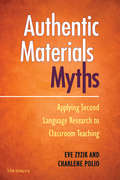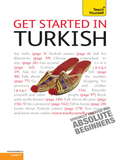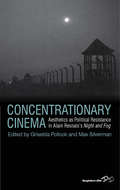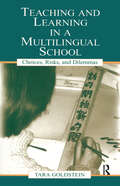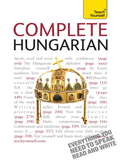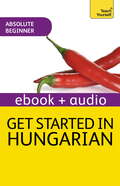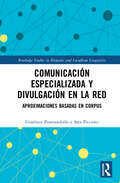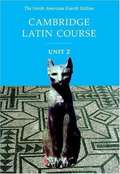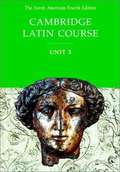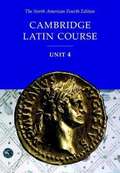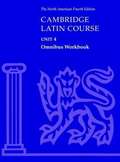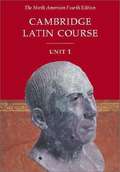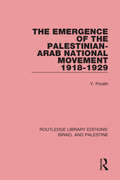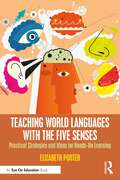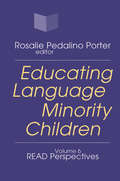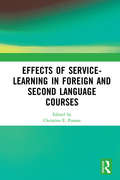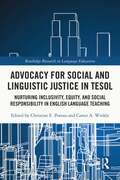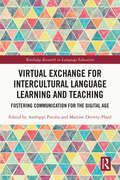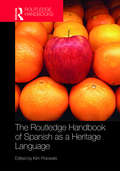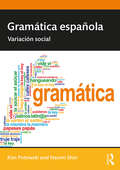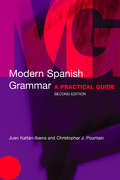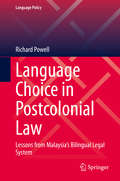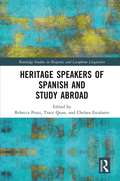- Table View
- List View
Authentic Materials Myths: Applying Second Language Research to Classroom Teaching
by Charlene Polio Eve ZyzikThe use of authentic materials in language classrooms is sometimes discussed as a reliable way to expose students to the target language, but there is also disagreement regarding what kinds of authentic materials should be used, when they should be used, and how much of the curriculum should revolve around them. This volume in the Myths series explores the research related to the use of authentic materials and the ways that authentic materials may be used successfully in the classroom. Like others in the Myths series, this book combines research with good pedagogical practices. The myths examined in this book are: Authentic texts are inaccessible to beginners.Authentic texts cannot be used to teach grammar.Shorter texts are more beneficial for language learners.Activating background knowledge or making a word list is sufficient to prepare students for authentic texts.Authentic texts can be used to teach only listening and reading.Modifying or simplifying authentic texts always helps language learners.For learners to benefit from using authentic texts, the associated tasks must also be authentic.The Epilogue explores the challenges of using authentic texts in the classroom and calls for more research.
Get Started in Beginner's Turkish: Teach Yourself
by Asuman Çelen PollardThis product is most effective when used in conjunction with the corresponding audio support.- You can purchase the book and double CD as a pack (ISBN: 9781444105506)- The double CD is also sold separately (ISBN: 9781444105513)(copy and paste the ISBN number into the search bar to find these products)Is this the right course for you?Are you looking for a course in Turkish written for the absolute beginner who has no experience of learning a foreign language? Get Started in Turkish will give you the confidence to communicate in Turkish. Now fully updated to make your language learning experience fun and interactive. You can still rely on the benefits of a top language teacher and our years of teaching experience, but now with added learning features within the course and online. The emphasis of the course is placed on communication, rather than grammar, and all the teaching is in English, so that you will quickly and effortlessly get started in Turkish. By the end of this course, you will be at Level B1 of the Common European Framework for Languages: can deal with most situations likely to arise whilst travelling in an area where the language is spoken. Get Started in Turkish includes:Chapter 1: GreetingsChapter 2: DrinksChapter 3: AccommodationChapter 4: Eating outChapter 5: DirectionsChapter 6: I like the weather here!Chapter 7: Talking about oneself and describing peopleChapter 8: ShoppingChapter 9: Where shall we go?Chapter 10: How was it?Learn effortlessly with new, easy-to-read page design and interactive features: Not got much time?One, five and ten-minute introductions to key principles to get you started.Author insightsLots of instant help with common problems and quick tips for success, based on the author's many years of experience.Useful vocabularyEasy to find and learn, to build a solid foundation for speaking.DialoguesRead and listen to everyday dialogues to help you speak and understand fast.PronunciationDon't sound like a tourist! Perfect your pronunciation before you go.Test yourselfTests in the book and online to keep track of your progress.Extend your knowledgeExtra online articles to give you a richer understanding of the culture and history of Turkey.Try thisInnovative exercises illustrate what you've learnt and how to use it
Concentrationary Cinema
by Griselda Pollock Max SilvermanSince its completion in 1955, Alain Resnais's Night and Fog (Nuit et Brouillard) has been considered one of the most important films to confront the catastrophe and atrocities of the Nazi era. But was it a film about the Holocaust that failed to recognize the racist genocide? Or was the film not about the Holocaust as we know it today but a political and aesthetic response to what David Rousset, the French political prisoner from Buchenwald, identified on his return in 1945 as the 'concentrationary universe' which, now actualized, might release its totalitarian plague any time and anywhere? What kind of memory does the film create to warn us of the continued presence of this concentrationary universe? This international collection re-examines Resnais's benchmark film in terms of both its political and historical context of representation of the camps and of other instances of the concentrationary in contemporary cinema. Through a range of critical readings, Concentrationary Cinema explores the cinematic aesthetics of political resistance not to the Holocaust as such but to the political novelty of absolute power represented by the concentrationary system and its assault on the human condition.
Teaching and Learning in a Multilingual School: Choices, Risks, and Dilemmas (Language, Culture, and Teaching Series)
by Gordon Pon Tara Goldstein Timothy Chiu Judith NganTeaching and Learning in a Multilingual School: Choices, Risks, and Dilemmas is for teachers and teacher educators working in communities that educate children who do not speak English as a first language. At the center of the book are findings from a four-year critical ethnographic case study of a Canadian high school with a large number of emigrant students from Hong Kong and rich descriptions of the multitude of ways teachers and students thought about, responded to, and negotiated the issues and dilemmas that arose. The solutions and insights they derived from their experiences of working across linguistic, cultural, and racial differences will be extremely valuable to educators in other locales that have become home to large numbers of immigrant families. The book is designed to help readers think about how the issues and dilemmas in the case study manifest themselves in their own communities and how to apply the insights they gain to their own teaching and learning contexts: * Each chapter includes four components: an excerpt from the ethnographic study; an analytic commentary on the ethnographic text drawn from a variety of theoretical perspectives and academic disciplines (including interactionist sociolinguistics, language minority education, English as a Second Language education, critical literacy, anti-racist education, and critical teacher education); a pedagogical discussion; and suggestions for further reflection and discussion. * The book features the use of ethnographic play writing to engage readers with the issues that arise in multicultural/multilingual schools. The author's play Hong Kong, Canada is included in its entirety and is used to stimulate further discussion of the issues raised in each of the chapters. * Although it is organized around two different kinds of schooling dilemmas--dilemmas of speech and silence, and dilemmas of discrimination--everyday dilemmas of curriculum and assessment are also discussed throughout the book. * A methodological discussion of the choices the author made while designing, conducting, and writing up the critical ethnographic case study makes the book useful in qualitative research methodology courses. * A set of strategies and activities is provided for helping students develop English oral presentation skills.
Complete Hungarian: Learn to read, write, speak and understand a new language with Teach Yourself (Teach Yourself)
by Zsuzsa PontifexAre you looking for a complete course in Hungarian which takes you effortlessly from beginner to confident speaker? <P><P>Whether you are starting from scratch, or are just out of practice, Complete Hungarian will guarantee success! Now fully updated to make your language learning experience fun and interactive. You can still rely on the benefits of a top language teacher and our years of teaching experience, but now with added learning features within the course and online. <P>The course is structured in thematic units and the emphasis is placed on communication, so that you effortlessly progress from introducing yourself and dealing with everyday situations, to using the phone and talking about work. By the end of this course, you will be at Level B2 of the Common European Framework for Languages: Can interact with a degree of fluency and spontaneity that makes regular interaction with native speakers quite possible without strain for either party.<P>Learn effortlessly with a new easy-to-read page design and interactive features: NOT GOT MUCH TIME? One, five and ten-minute introductions to key principles to get you started. AUTHOR INSIGHTS: Lots of instant help with common problems and quick tips for success, based on the author's many years of experience. GRAMMAR TIPS: Easy-to-follow building blocks to give you a clear understanding. USEFUL VOCABULARY: Easy to find and learn, to build a solid foundation for speaking. DIALOGUES: Read and listen to everyday dialogues to help you speak and understand fast. PRONUNCIATION: Don't sound like a tourist! Perfect your pronunciation before you go. TEST YOURSELF: Tests in the book and online to keep track of your progress. EXTEND YOUR KNOWLEDGE: Extra online articles at: www.teachyourself.com to give you a richer understanding of the culture and history of Hungary. TRY THIS: Innovative exercises illustrate what you've learnt and how to use it.
Get Started in Hungarian Absolute Beginner Course: Enhanced Edition
by Zsuzsa PontifexIf you are an absolute beginner or simply looking for a solid foundation to your Hungarian language studies for school, work or travel, this engaging course will help get you on your way to speaking, writing, reading and understanding Hungarian in no time. Get Started in Beginner's Hungarian maps from A1 to A2 of the Common European Framework of Reference (CEFR) for Languages.Through culture notes, clear language presentations, and extensive practice and review, you will pick up the Hungarian you need to communicate naturally in everyday situations - from shopping and travelling to food and daily life.Engaging with our interactive Discovery Method, you'll absorb language rules faster, remember what you learn easily, and put your Hungarian into use with confidence.Get Started in Beginner's Hungarian has a learner-centered approach that incorporates the following features:-Outcomes-based approach - focus your learning with clear goals-Learn to learn - tips and skills on how to be a better language learner-Discovery method - figure out rules and patterns for yourself to make the language stick-Self-check and test yourself - see and assess your own progress -Personalization - use the language in real situationsRely on Teach Yourself, trusted by language learners for over 70 years.
Complete Hungarian Beginner to Intermediate Book and Audio Course: Learn to read, write, speak and understand a new language with Teach Yourself
by Zsuzsanna PontifexAre you looking for a complete course in Hungarian which takes you effortlessly from beginner to confident speaker? Whether you are starting from scratch, or are just out of practice, Complete Hungarian will guarantee success!Now fully updated to make your language learning experience fun and interactive. You can still rely on the benefits of a top language teacher and our years of teaching experience, but now with added learning features within the course and online. The course is structured in thematic units and the emphasis is placed on communication, so that you effortlessly progress from introducing yourself and dealing with everyday situations, to using the phone and talking about work. By the end of this course, you will be at Level B2 of the Common European Framework for Languages: Can interact with a degree of fluency and spontaneity that makes regular interaction with native speakers quite possible without strain for either party.Learn effortlessly with a new easy-to-read page design and interactive features: NOT GOT MUCH TIME?One, five and ten-minute introductions to key principles to get you started.AUTHOR INSIGHTSLots of instant help with common problems and quick tips for success, based on the author's many years of experience.GRAMMAR TIPSEasy-to-follow building blocks to give you a clear understanding.USEFUL VOCABULARYEasy to find and learn, to build a solid foundation for speaking.DIALOGUESRead and listen to everyday dialogues to help you speak and understand fast.PRONUNCIATIONDon't sound like a tourist! Perfect your pronunciation before you go.TEST YOURSELFTests in the book and online to keep track of your progress.EXTEND YOUR KNOWLEDGEExtra online articles at: www.teachyourself.com to give you a richer understanding of the culture and history of Hungary.TRY THISInnovative exercises illustrate what you've learnt and how to use it.
Comunicación especializada y divulgación en la red: aproximaciones basadas en corpus (Routledge Studies in Hispanic and Lusophone Linguistics)
by Gianluca Pontrandolfo Sara PiccioniComunicación especializada y divulgación en la red: aproximaciones basadas en corpus adopta un enfoque basado en corpus para analizar los principales rasgos discursivos de la divulgación y de la comunicación especializada en español. El volumen presenta un modelo teórico para el estudio de la divulgación en los géneros digitales y lo aplica a una serie de estudios de caso que analizan diferentes rasgos (entre otros, la metáfora, la polifonía o los encuadres discursivos) que permiten caracterizar cómo se comunican contenidos especializados a un público lego. La investigación se basa en el corpus WebLesp, que contiene distintos géneros digitales en cuatro ámbitos sectoriales: medicina, derecho, economía y ciencia. El volumen se dirige a investigadores expertos y principiantes, así como a alumnado y profesorado, interesados en la lingüística española, el análisis de género, el análisis del discurso, el español para fines específicos y la lingüística de corpus. Comunicación especializada y divulgación en la red: aproximaciones basadas en corpus presents a corpus-based approach to the study of the key features of popularization and specialised communication in Spanish. Providing a theoretical framework for the study of popularization in web genres, this book proposes a series of case studies exploring a range of features (including metaphor, polyphony and discourse frames) that contribute to characterise how specialised knowledge is communicated to lay audiences. The research is based on the WebLesp corpus, containing different web genres pertaining to four major domains: law, economics, medicine, and science. This will be of particular interest to researchers and advanced students in Spanish Linguistics, Genre Analysis, Discourse Analysis, Spanish for Specific Purposes and Corpus Linguistics.
Cambridge Latin Course, Unit 2
by Stephanie Pope Patricia E. Bell Stan Farrow Richard M. Popeck Anne Shaw Peter Kesteven Joy Mellor Leslie JonesThe Fourth Edition Cambridge Latin Course is an introductory program organized into four well-integrated units. Cambridge's proven approach includes a stimulating continuous story line, interwoven grammatical development and cultural information, supportive illustrations and photographs, and a complete Language Information section. Reading is the heart of the Cambridge Latin Course, and all the elements of the program - illustrations, vocabulary, grammar and syntax, cultural contexts and references, activities - are carefully introduced and arranged to provide students with the skills they need to read with comprehension and enjoyment from the very first page. Student Book The most effective tool for students and teachers of Latin! A continuous and motivating story line captures and holds students' imagination. . . The logical pattern of each Stage and careful integration among Stages and Units train students to read Latin with ease and to understand the culture of the Romans. . . Clear language explanations and examples and ample practice insure student mastery of Latin. . . And rich illustrations bring the works and experiences of the Romans to life.
Cambridge Latin Course, Unit 3
by Stephanie Pope Patricia E. Bell Stan Farrow Richard M. Popeck Anne Shaw Joy Mellor Leslie Jones Peter Kesteven Neil SuttonThe North American Cambridge Latin Course is a well-established four-part Latin program whose approach combines a stimulating, continuous storyline with grammatical development, work on derivatives, and cultural information. There is also a complete Language Information section, plus numerous color photographs illustrating life in the Roman world. The Course has now been fully revised and updated in the light of feedback from user schools, and includes the very best in new research. The Fourth Edition continues to offer teachers and students alike a stimulating, reading-based approach to the study of Latin.
Cambridge Latin Course, Unit 4
by Stephanie M. Pope Patricia E. Bell Stan Farrow Richard M. Popeck Anne Shaw Peter Kesteven Joy Mellor Leslie JonesThe North American Cambridge Latin Course is a well-established four-part Latin program whose approach combines a stimulating, continuous storyline with grammatical development, work on derivatives, and cultural information. There is also a complete Language Information section, plus numerous color photographs illustrating life in the Roman world. The Course has now been fully revised and updated in the light of feedback from user schools, and includes the very best in new research. The Fourth Edition continues to offer teachers and students alike a stimulating, reading- based approach to the study of Latin.
Cambridge Latin Course, Unit 4, Omnibus Workbook
by Stephanie M. Pope Patricia E. Bell Stan Farrow Richard M. Popeck Anne Shaw Joy Mellor Leslie Jones Peter Kesteven Neil SuttonThe North American Cambridge Latin Course is a well-established four-part Latin program whose approach combines a stimulating, continuous storyline with grammatical development, work on derivatives, and cultural information. There is also a complete Language Information section, plus numerous color photographs illustrating life in the Roman world. The Course has now been fully revised and updated in light of feedback from user schools, and includes the very best in new research. The Fourth Edition continues to offer teachers and students alike a stimulating, reading-based approach to the study of Latin. The Omnibus Workbook is designed to be used in conjunction with the Unit 4 Student's Text. A variety of exercises is provided for each Stage.
Cambridge Latin Course, Unit 1
by Stephanie M. Pope Patricia E. Bell Stan Farrow Anne Shaw Randy Thompson Joy Mellor Leslie Jones Peter Kesteven Neil SuttonThe Fourth Edition Cambridge Latin Course is an introductory program organized into four well-integrated units. Cambridge's proven approach includes a stimulating continuous story line, interwoven grammatical development and cultural information, supportive illustrations and photographs, and a complete Language Information section. Reading is the heart of the Cambridge Latin Course, and all the elements of the program - illustrations, vocabulary, grammar and syntax, cultural contexts and references, activities - are carefully introduced and arranged to provide students with the skills they need to read with comprehension and enjoyment from the very first page.
The Emergence of the Palestinian-Arab National Movement, 1918-1929 (RLE Israel and Palestine)
by Yehoshua PorathThe resurgence of Palestinian nationalism in the wake of the 1967 Arab-Israeli war tended to overshadow the fact that Palestinian national consciousness is not a new phenomenon, but traces its origins back to the time when the first stirrings of nationalism were being felt in many parts of the under-developed world. This work, first published in 1974, is based on both Arabic and Hebrew primary sources as well as English and French official and unofficial documents, and was the first detailed study of the infancy period of Palestinian nationalism. The book begins by establishing the position of Palestine and Jerusalem in Islamic history and their significance within the concepts of Islam, and outlines the social and political features of the Palestinian population at the beginning of the First World War. The author then charts in detail the development of Palestinian nationalism over the decade after the War. Two major forces influenced this development and reacted with it: Zionism, with its ambitious schemes for settling Jews in Palestine and creating a National Home for them there, and Arab nationalism on a wider scale, which was emerging spontaneously with the disintegration of the Ottoman Empire and the spreading of ideas of self-determination. The growing threat posed by Zionism awoke the Palestinian population to the need for organization and the establishment of their own identity to oppose it, while the focus of their national aspirations widened or narrowed according to the ability which they felt at any given time to confront Zionism and achieve self-expression within a Palestinian rather than an all-Syrian national framework. The events of these turbulent years – the confrontations with the British, delegations, boycotts, proposals and rejections, the emergence of al-Hajj Amin al-Husayni, the Wailing Wall conflict and its repercussions – are all described within the context of these wider considerations, which also include Britain’s own role as holder of the Mandate over Palestine.
Teaching World Languages with the Five Senses: Practical Strategies and Ideas for Hands-On Learning
by Elizabeth PorterWith this fun, practical guide, you will have everything you need to re-envision and reinvigorate your world language classroom. Author Elizabeth Porter draws on a brain-based approach to show how language learning is a sensory experience. Students can effectively learn languages and improve retention through activities and lessons that incorporate the five senses – sight, hearing, taste, touch, and smell. Chapters include real-world, research-backed examples and classroom strategies and activities ready for use. An essential resource for world language teachers, this book introduces language learning philosophy and an out-of-the-box, effective approach that uses neuroscience combined with best practices to promote a highly engaging language learning environment.
Teaching World Languages with the Five Senses: Practical Strategies and Ideas for Hands-On Learning
by Elizabeth PorterWith this fun, practical guide, you will have everything you need to re-envision and reinvigorate your world language classroom. Author Elizabeth Porter draws on a brain-based approach to show how language learning is a sensory experience. Students can effectively learn languages and improve retention through activities and lessons that incorporate the five senses – sight, hearing, taste, touch, and smell. Chapters include real-world, research-backed examples and classroom strategies and activities ready for use. An essential resource for world language teachers, this book introduces language learning philosophy and an out-of-the-box, effective approach that uses neuroscience combined with best practices to promote a highly engaging language learning environment.
Educating Language Minority Children
by Rosalie PorterREAD Perspectives, a refereed annual publication of the Institute for Research in English Acquisition and Development (READ), Washington, D.C., begins its sixth year with the theme "Educating Language Minority Children: An Agenda for the Future." Volume 6 features presentations from a Boston University conference organized by READ and the Pioneer Institute. The essays represent truly diverse viewpoints on the education of limited-English students, rare in the complex and contentious arena of bilingual education.The lead article, "Rethinking Bilingual Education," by Charles L Glenn of Boston University, inspired the conference's organization. Dr. Glenn proposes new ways of schooling limited-English-speaking children that depart dramatically from the practices of the past 30 years. He proposes sound recommendations for revising Massachusetts bilingual education law, ideas that could well be applied in other states. Also included areChristine Rossell's "Mystery on the Bilingual Express," a critique of the controversial study by Thomas and Collier; Rosalie Pedalino Porter's follow-up review of El Paso, Texas's programs for English learners; Mark Lopez's "Labor Market Effects of Bilingual Education"; "Bethlehem, Pennsylvania's English Acquisition Program," by Thomas J. Dolusio; Maria Estela Brisk's discussion on the need to restructure schools to incorporate the large non-English student population; several articles regarding educational reform in Massachusetts, including two by school superintendents Eugene Creedon and Douglas Sears, and one by Harold Lane, Chairman of the Joint Education Committee in the Massachusetts Legislature; and, finally, Kevin Clark's "From Primary Language Instruction to English Immersion: How Five California Districts Made the Switch." Kevin Clark's California study "From Primary Language Instruction to English Immersion: How Five California Districts Made the Switch," describes how radical changes are being carried out in a few representative school districts since passage of California Proposition 227, the "English for the Children" initiative. Educating Language Minority Children is a valuable selection of the most current thinking on policies, programs, and practices affecting limited-English students in U.S. public schools. It provides a wealth of practical information useful to educators, parents, legislators, and policy analysts, and is an essential addition to libraries nationwide.
Effects of Service-Learning in Foreign and Second Language Courses
by Christine E. PoteauThis edited volume brings together several original studies that critically examine the quantitative and qualitative effects of service-learning (SL) on foreign and second language learning, and its impact on communities, learners, pre-service teacher candidates, and faculty-researchers. The book focuses on two key aspects: Innovative SL methodologies that seek to develop linguistic and cultural competencies and empirical investigations on the SL effects on all stakeholders. The analysis presented provides a unique insight into the challenges and future directions of SL research, pedagogical assessment, and community impact.
Advocacy for Social and Linguistic Justice in TESOL: Nurturing Inclusivity, Equity, and Social Responsibility in English Language Teaching (Routledge Research in Language Education)
by Christine E. Poteau Carter A. WinkleRecognizing the need for increased social justice in the fields of TESOL and English Language Teaching (ELT) globally, this volume presents a range of international case studies and empirical research to demonstrate how English language instruction can promote social and linguistic justice through advocacy-oriented pedagogies and curricula. Advocacy for Social and Linguistic Justice in TESOL adopts a critical, and evidence-based approach to identifying effective practice in ensuring inclusive and equitable learning and teaching. Chapters address emergent issues including heritage language and L1 attrition, teacher and learner identity, and linguistic colonialism, as well as wider issues such as global citizenship and human rights. Focus is placed on empowering both educators and learners as advocates of social justice and consideration is also given to how social responsibility can be supported through enhanced teacher preparation and professional development. Making a timely contribution at the intersection of advocacy, social justice, and English language teaching, this book will be key reading for postgraduate researchers, scholars, and academics in the fields of TESOL and ELT, as well as language education, applied linguistics, and the sociology of education more broadly. English language teachers and practitioners will also find this volume of interest.
Virtual Exchange for Intercultural Language Learning and Teaching: Fostering Communication for the Digital Age (Routledge Research in Language Education)
by Anthippi Potolia Martine Derivry-PlardThis book illustrates new virtual intercultural practices for language learning from primary to tertiary education and highlights the transversality of these practices throughout the language curriculum. The current English as a Lingua Franca (ELF) perspective sets the framework as a possible vector of cultural exchanges in a variety of contexts, and from which the different authors coming from Europe and all over the world present their studies. The book deploys diverse educational exchanges within a wide range of technological tools and with varied approaches to the intercultural dimension in language learning. Through these virtual exchanges, different languages and educational cultures come together to create emerging communities of practice co-constructed for the limited time-space of the collaborative projects. This volume opens a dialogue with researchers from different backgrounds and theoretical and methodological perspectives as technology can no longer be apprehended without its purposeful human and semiotic meanings and, conversely, human and semiotic meanings can no longer be apprehended without Information and Communication Technology (ICT). Going beyond strict polarised views on the technology or humanistic approaches, this book presents a more nuanced, interrelated stance and will appeal to researchers, scholars, post graduate students, and teachers in applied linguistics, language learning and teaching, education, information studies, cultural studies, and intercultural communication.
The Routledge Handbook of Spanish as a Heritage Language (Routledge Spanish Language Handbooks)
by Kim PotowskiThe Routledge Handbook of Spanish as a Heritage Language brings together contributions from leading linguists, educators and Latino Studies scholars involved in teaching and working with Spanish heritage language speakers. This state-of-the-art overview covers a range of topics within five broad areas: Spanish in U.S. public life, Spanish heritage language use and systems, educational contexts, Latino studies perspectives and Spanish outside the U.S. The Routledge Handbook of Spanish as a Heritage Language addresses for the first time the linguistic, educational and social aspects of heritage Spanish speakers in one volume making it an indispensable reference for anyone working with Spanish as a heritage language.
Gramática española: Variación social
by Kim Potowski Naomi L. ShinGramática española: Variación social introduces intermediate to advanced students of Spanish to the main grammatical features of the language in a way that emphasizes the social underpinnings of language. Written entirely in Spanish, this unique approach to the study of grammar guides students in an examination of how Spanish grammar varies depending on place, social group, and situation. Students examine why some varieties of Spanish are considered prestigious while others are not, drawing on current and historical sociopolitical contexts, all while learning grammatical terminology and how to identify categories and constructions in Spanish. This is an excellent resource for students at level B1 or higher on the Common European Framework for Languages, and Intermediate High to Advanced High on the ACTFL proficiency scale.
Modern Spanish Grammar: A Practical Guide (Modern Grammars)
by Christopher Pountain Juan Kattan-Ibarra Christopher J. Pountain Juan Kattán-IbarraModern Spanish Grammar: A Practical Guide is an innovative reference guide to Spanish, combining traditional and function-based grammar in a single volume.The Grammar is divided into two parts. The shorter section covers traditional grammatical categories such as word order, nouns, verbs and adjectives. The larger section is carefully organized around language functions and notions such as: giving and seeking information putting actions into context* expressing likes, dislikes and preferences comparing objects and actions.All grammar points and functions are richly illustrated and information is provided on register and relevant cultural background. Written by experienced teachers and academics, the Grammar has a strong emphasis on contemporary usage. Particular attention is paid to indexing and cross-referencing across the two sections. This is the ideal reference grammar for learners of Spanish at all levels, from elementary to advanced. It will prove invaluable to those with little experience of formal grammar, as no prior knowledge of grammatical terminology is assumed and a glossary of terms is provided. The book will also be useful to teachers seeking back-up to functional syllabuses, and to designers of Spanish courses.
Language Choice in Postcolonial Law: Lessons from Malaysia’s Bilingual Legal System (Language Policy #22)
by Richard PowellThis book discusses multilingual postcolonial common law, focusing on Malaysia’s efforts to shift the language of law from English to Malay, and weighing the pros and cons of planned language shift as a solution to language-based disadvantage before the law in jurisdictions where the majority of citizens lack proficiency in the traditional legal medium. Through analysis of legislation and policy documents, interviews with lawyers, law students and law lecturers, and observations of court proceedings and law lectures, the book reflects on what is entailed in changing the language of the law. It reviews the implications of societal bilingualism for postcolonial justice systems, and raises an important question for language planners to consider: if the language of the law is changed, what else about the law changes?
Heritage Speakers of Spanish and Study Abroad (Routledge Studies in Hispanic and Lusophone Linguistics)
by Rebecca PozziHeritage Speakers of Spanish and Study Abroad is an edited volume that provides emerging research on heritage speakers of Spanish in immersion contexts in theoretical, empirical, and programmatic terms. This edited collection seeks to expand our understanding of heritage speakers of Spanish by incorporating research on their linguistic, sociolinguistic, and pragmatic development during and after a sojourn abroad, by discussing the complexities of their identity formation and negotiation during immersive stays, and by highlighting programmatic innovations that could be leveraged to better serve diverse learners in study abroad contexts. This volume advances the fields of both heritage language education and research on immersion study in a variety of ways, and will be of interest to scholars of applied linguistics, sociolinguistics, second language acquisition, and educational linguistics, especially those interested in study abroad programming and Spanish for heritage speakers.
